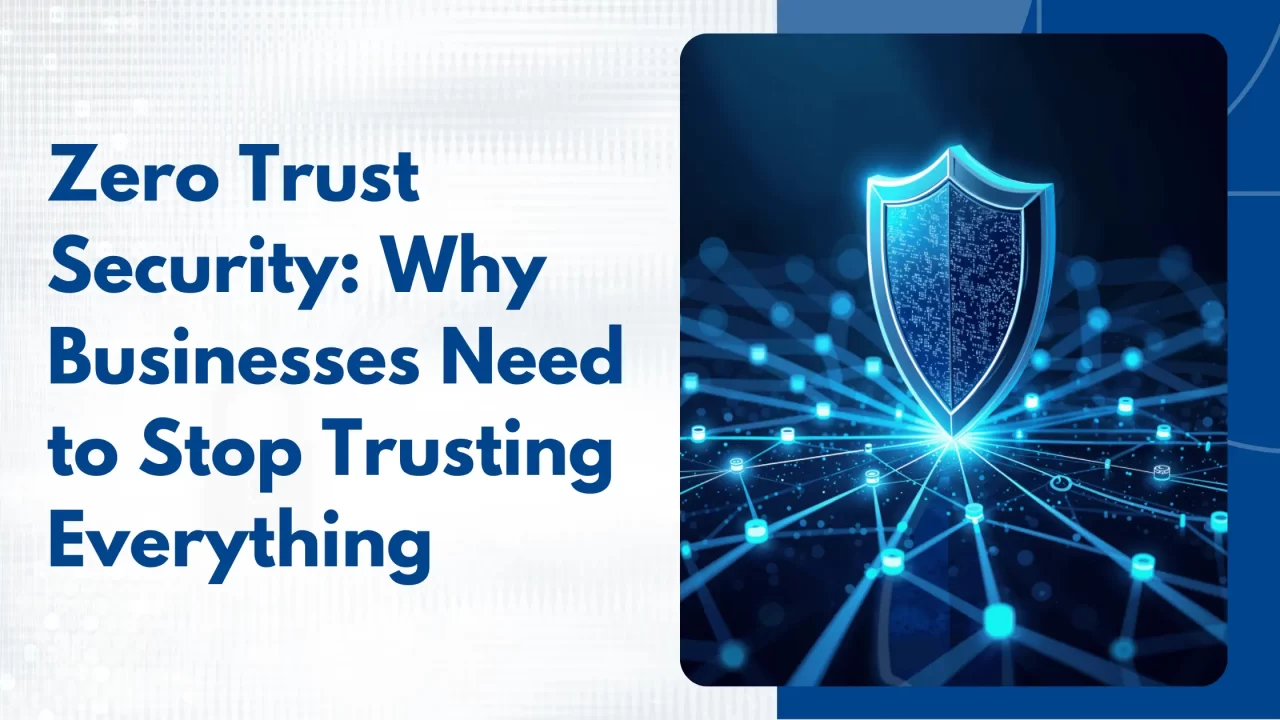In today’s ever-evolving cyber landscape, traditional security models are no longer sufficient to protect businesses from advanced threats. Attackers exploit gaps in perimeter-based defences, making organizations vulnerable to data breaches, insider threats, and ransomware attacks. This is where the Zero Trust Security model comes into play.
The Zero Trust model is built on the principle of ‘never trust, always verify’, ensuring that no user or device is trusted by default. Instead, access is continuously authenticated, authorized, and monitored. Whether securing endpoint security, cloud environments, or internal networks, Zero Trust provides a proactive security framework to protect modern businesses.
What is Zero Trust Security?
Zero Trust is a comprehensive cybersecurity approach that requires strict identity verification for every person and device attempting to access resources on a private network. Unlike traditional perimeter-based security models, Zero Trust assumes that threats exist both outside and inside the network.
Core Principles of Zero Trust Security:
- Verify Explicitly: Authenticate and authorize every access request based on multiple factors (MFA, biometrics, device compliance, etc.).
- Least Privilege Access: Limit user access to only what is necessary for their role, reducing potential attack surfaces.
- Micro-Segmentation: Divide the network into smaller, isolated zones to prevent lateral movement in case of a breach.
- Continuous Monitoring: Log, analyse, and respond to all security events in real-time.
- Adaptive Security Policies: Automate security decisions based on risk levels, user behaviour, and compliance requirements.
How Zero Trust Enhances Endpoint and Cloud Security
Zero Trust Security is essential for securing both endpoint devices and cloud environments, where traditional security measures often fail.
- Securing Endpoint Devices with Zero Trust
- Device Authentication: Enforces strict access policies based on the device’s security posture.
- Endpoint Detection & Response (EDR): Continuously monitors endpoint behaviour to detect anomalies and threats.
- Zero Trust Network Access (ZTNA): Grants least-privilege access to endpoints based on user identity and compliance status.
- Protecting Cloud Environments with Zero Trust
- Cloud Access Security Broker (CASB): Ensures secure access and compliance for cloud applications.
- Identity and Access Management (IAM): Implements MFA and role-based access control (RBAC) for cloud users.
- API Security: Protects APIs from unauthorized access, injection attacks, and data leakage.
By applying Zero Trust principles to both endpoints and cloud environments, businesses can mitigate risks associated with phishing attacks, insider threats, and malware infections.
Implementation Roadmap for Businesses
Adopting a Zero Trust model requires a strategic approach. Here’s a step-by-step roadmap for businesses to implement Zero Trust Security effectively:
Step 1: Assess Current Security Posture
- Conduct a security audit to identify existing vulnerabilities.
- Map out critical assets, users, and data flows within the organization.
Step 2: Enforce Strong Identity & Access Management (IAM)
- Implement Multi-Factor Authentication (MFA) for all users.
- Apply role-based access controls (RBAC) to limit permissions.
- Use continuous identity verification based on user behaviour.
Step 3: Implement Micro-Segmentation
- Divide the network into smaller segments to restrict unauthorized access.
- Isolate sensitive data and applications to minimize breach impact.
Step 4: Deploy Zero Trust Network Access (ZTNA)
- Replace traditional VPNs with ZTNA solutions to provide secure, identity-based access.
- Ensure secure access for remote workers and third-party vendors.
Step 5: Continuously Monitor and Automate Threat Detection
- Use real-time analytics to detect and respond to threats.
- Deploy AI-driven security automation to reduce manual intervention.
- Conduct regular security assessments and compliance audits.
Why Businesses Should Adopt Zero Trust Now
Cyberattacks are more frequent and sophisticated than ever, making Zero Trust Security a necessity rather than an option. Companies that rely on traditional perimeter security risk massive financial losses, reputational damage, and regulatory penalties.
Key Benefits of Zero Trust:
✔ Enhanced Data Security: Prevents unauthorized access and data breaches.
✔ Improved Compliance: Meets security standards like ISO 27001, GDPR, and NIST.
✔ Stronger Endpoint Protection: Reduces the risk of ransomware and insider threats.
✔ Seamless Remote Work Security: Ensures secure access for remote employees.
✔ Reduced Attack Surface: Minimizes exposure to cyber threats through least-privilege access.
Final Thoughts: The Future is Zero Trust
Zero Trust Security is no longer an emerging trend—it is the gold standard for modern cybersecurity. Businesses that implement Zero Trust principles can stay ahead of evolving cyber threats, ensure robust endpoint security, and secure cloud infrastructures.
Take Action: Strengthen Your Security with Zero Trust Today!
Don’t wait for a cyberattack to happen. Schedule a consultation with Vanaps and discover how Zero Trust Security can protect your business from modern threats.



